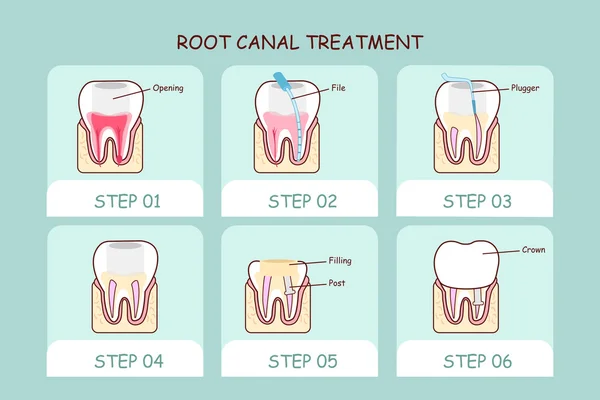Root canal treatment is a type of endodontic therapy that is necessary to save the form and function of an inflamed and infected tooth.
It is a widely accepted, extremely effective, and safe treatment approach for people whose tooth pulps have become injured and can affect the functionality of adjacent teeth.
Sometimes, due to poor oral hygiene routines, bacteria enter the pulp of a tooth and cause an infection. When this occurs, root canal therapy is the only option left to save the tooth.
During this process, the inflamed or infected pulp is removed, and the tooth is sealed to prevent reinfection.
This endodontic therapy is specifically designed to eliminate bacteria from the infected root canal, prevent reinfection of the tooth and save the structure of the natural tooth.
Signs That Indicate You Might Need a Root Canal Treatment
If you are suffering from any of the following oral problems, you might be in need of root canal therapy:
Constant pain:
One of the most significant symptoms of root canal treatment that indicate you might require a treatment of root canal is constant and throbbing pain in the affected tooth.
This can either be constant or periodic pain. In such situations, people might feel the pain in parts other than their teeth, like their face, jaw, or their other teeth, and may also feel it deep in the tooth’s bone.
However, in some cases, tooth pain can also indicate some other issues, like a damaged filling, a cavity, transferred pain from a sinus infection, or gum disease.
Whatever the reason, if you feel persistent pain, it is always a good idea to consult your dentist to diagnose the root cause of the problem.
Sensitivity to heat and cold:
If you experience constant pain in your tooth while you are having something extremely cold or hot, you might need root canal treatment.
The sensitivity can manifest as a throbbing pain or a dull ache if you can feel it for a longer period, even after you have had your food. It might mean that the nerves in your tooth have become infected or damaged.
A cracked or chipped tooth:
If you have a chipped or cracked tooth, bacteria can appear on its surface and cause an infection.
Even if the tooth is not cracked and is just injured, it can still damage the nerves to the point where it can only get repaired through root canal therapy.
Some other signs that indicate that you are in need of a root canal include swelling or tenderness of the gums and bumps. That looks like pimples on the affected area and dislocation of the tooth.
A discoloured tooth:
Our teeth can get discolored if they have an infected pulp. Such teeth can appear greyish or black-toned due to damage to the roots caused by a breakdown of the internal tissue.
Although other things can cause tooth discoloration, you should see an endodontist as soon as possible if your tooth is starting to change color.
The Procedure for Treating Root Canal Infections
A general dentist or an endodontist performs root canal therapy. Mostly, this procedure is completed in one to two appointments.
In the first appointment, the dentist removes the infected and inflamed pulp. During the second appointment, the tooth’s roots get cleaned and filled with a crown or other filling in order to prevent reinfections.
Here is a step-by-step guide to the root canal procedure:
- Firstly, the dentist initiates this process by giving the patient local anesthesia to numb the infected tooth and the surrounding gums. Dentistry also uses medications to help patients feel relaxed and comfortable during the entire treatment process, such as oral sedatives, nitrous oxide, or intravenous (IV) sedation. The healthcare provider might also recommend sedation for patients who struggle with dental anxiety.
- After that, a dental rubber dam is placed over the affected area. This dam isolates the damaged tooth and keeps it dry during the whole procedure.
- In the next step, a small opening is made in the tooth’s crown to access the tooth’s pulp.
- After that, tiny dental instruments are utilized in order to remove the infected blood vessels, tissues, and nerves, inside the tooth.
- Once the infected pulp is removed, the root canals and the pulp chamber are disinfected, cleaned, and shaped.
- Then the empty canals are filled with a flexible dental material called gutta-percha.
- Next, a temporary dental filling is placed over the affected tooth in order to seal the tooth and prevent bacteria from re-entering.
In most cases of root canal therapy, patients usually need a dental crown. To protect the treated tooth and restore its bite. Crowns are custom-made and are fabricated within two to three weeks.
During the Second Appointment
When the crown is ready, the temporary filling placed over the affected tooth is removed, and the permanent crown is placed. In some cases, the dentist might place the crown during the same appointment.
Side Effects of Root Canal Therapy
Although root canal therapy is a completely safe procedure, in some cases, if proper care is not taken, it can result in serious complications.
Some common risk factors usually include:
Color Changes:
The dental pulp is the living part inside our teeth and contains nerves and connective tissue. And blood vessels, and after root canal therapy, some patients can experience discoloration in the treated tooth.
Because when the tooth’s pulp is removed, the tooth dies. As a result, the dead roots of the tooth become visible through the dentin.
However, this is a very rare case. But, if discoloration happens in the affected tooth. It can be aesthetically corrected with the help of veneers or dental crowns.
Sinus Congestion:
Another potential risk of this procedure is sinus congestion. The organs of our bodies are interlinked with each other, and teeth are no different. Therefore, a fairly common risk with root canals is that they can lead to problems like sinus congestion.
Because, in some cases, liquid in the jaw can leak slightly through the membranes in the patient’s nose. Whilst this is not a life-threatening condition, still, inflammation in the sinus cavities. It can become irritating and result in persistent headaches.
Reinfection:
Reinfection is the most common complication of a root canal procedure. And can happen if the procedure of the root canal is not performed properly. It can also occur if patients do not follow the aftercare program suggested by their dental professionals.
Author’s Bio:
My name is Alina Martin. Digital marketing and content writer expert at Ingersoll dental. Currently working on Ingersoll dental website.
https://www.balsamdental.com/symptoms-you-need-root-canal-treatment/








